On November 27, 1990 I visited Petrified Forest National Park and Painted Desert on my way back to California after visiting my parents in Dallas, Texas over Thanksgiving. There was some fresh snow on the ground.
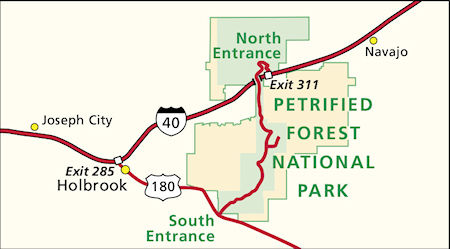
Petrified Forest National Park Location Map 2006
Petrified Forest - More Spectacular Than Ever - Full Movie
Petrified Forest National Park is in Navajo and Apache counties in northeastern Arizona. Named for its large deposits of petrified wood, the fee (chargeable) area of the park covers about 230 square miles, encompassing semi-desert shrub steppe as well as highly eroded and colorful badlands.
The park's headquarters is about 26 miles east of Holbrook along Interstate 40, which parallels the BNSF Railway's Southern Transcon, the Puerco River, and historic U.S. Route 66, all crossing the park roughly east–west.
The site, the northern part of which extends into the Painted Desert, was declared a national monument in 1906 and a national park in 1962. The park received 644,922 recreational visitors in 2018. Typical visitor activities include sightseeing, photography, hiking, and backpacking.
Averaging about 5,400 feet in elevation, the park has a dry windy climate with temperatures that vary from summer highs of about 100 °F to winter lows well below freezing. More than 400 species of plants, dominated by grasses such as bunchgrass, blue grama, and sacaton, are found in the park.
Fauna include larger animals such as pronghorns, coyotes, and bobcats, many smaller animals, such as deer mice, snakes, lizards, seven kinds of amphibians, and more than 200 species of birds, some of which are permanent residents and many of which are migratory. About one third of the park is designated wilderness—50,260 acres (79 square miles).
The Petrified Forest is known for its fossils, especially fallen trees that lived in the Late Triassic Epoch, about 225 million years ago. The sediments containing the fossil logs are part of the widespread and colorful Chinle Formation, from which the Painted Desert gets its name.
Beginning about 60 million years ago, the Colorado Plateau, of which the park is part, was pushed upward by tectonic forces and exposed to increased erosion. All of the park's rock layers above the Chinle, except geologically recent ones found in parts of the park, have been removed by wind and water.
In addition to petrified logs, fossils found in the park have included Late Triassic ferns, cycads, ginkgoes, and many other plants as well as fauna including giant reptiles called phytosaurs, large amphibians, and early dinosaurs. Paleontologists have been unearthing and studying the park's fossils since the early 20th century.
The park's earliest human inhabitants arrived at least 8,000 years ago. By about 2,000 years ago, they were growing corn in the area and shortly thereafter building pit houses in what would become the park.
Later inhabitants built above-ground dwellings called pueblos. Although a changing climate caused the last of the park's pueblos to be abandoned by about 1400 CE, more than 600 archeological sites, including petroglyphs, have been discovered in the park.
In the 16th century, Spanish explorers visited the area, and by the mid-19th century a U.S. team had surveyed an east–west route through the area where the park is now located and noted the petrified wood. Later, roads and a railway followed similar routes and gave rise to tourism and, before the park was protected, to large-scale removal of fossils. Theft of petrified wood remains a problem in the 21st century.
Petrified Forest National Park straddles the border between Apache County and Navajo County in northeastern Arizona. The park is about 30 miles long from north to south, and its width varies from a maximum of about 12 miles in the north to a minimum of about 1 mile along a narrow corridor between the north and south, where the park widens again to about 4 to 5 miles.
I-40, former U.S. Route 66, the BNSF Railway, and the Puerco River bisect the park generally east–west along a similar route. Adamana, a ghost town, is about 1 mile west of the park along the BNSF tracks. Holbrook, about 26 miles west of park headquarters along I-40, is the nearest city.
Bisecting the park north–south is Park Road, which runs between I-40 near park headquarters on the north and U.S. Route 180 on the south. Historic Highway 180, an earlier alignment of the modern route, crosses the southern edge of the park. Like Route 66, it has deteriorated and is closed. Many unpaved maintenance roads, closed to the public, intersect Park Road at various points.
The fee area of the park covers about 230 square miles. The Navajo Nation borders the park on the north and northeast. State-owned land, federal land controlled by the Bureau of Land Management, and private land, much of it used for cattle ranching, adjoin the other borders.
The park’s elevation above sea level varies from a low of 5,340 feet along the Puerco River to a high of 6,230 feet at Pilot Rock; the average elevation is about 5,400 feet. The terrain varies from gentle hills and major petrified wood deposits in the south to eroded badlands in the north.
Most of the park's intermittent streams—including Lithodendron Wash, Dead Wash, Ninemile Wash, and Dry Wash—empty into the Puerco River. In the southern part of the park, Cottonwood Wash and Jim Camp Wash flow into the Little Colorado River.
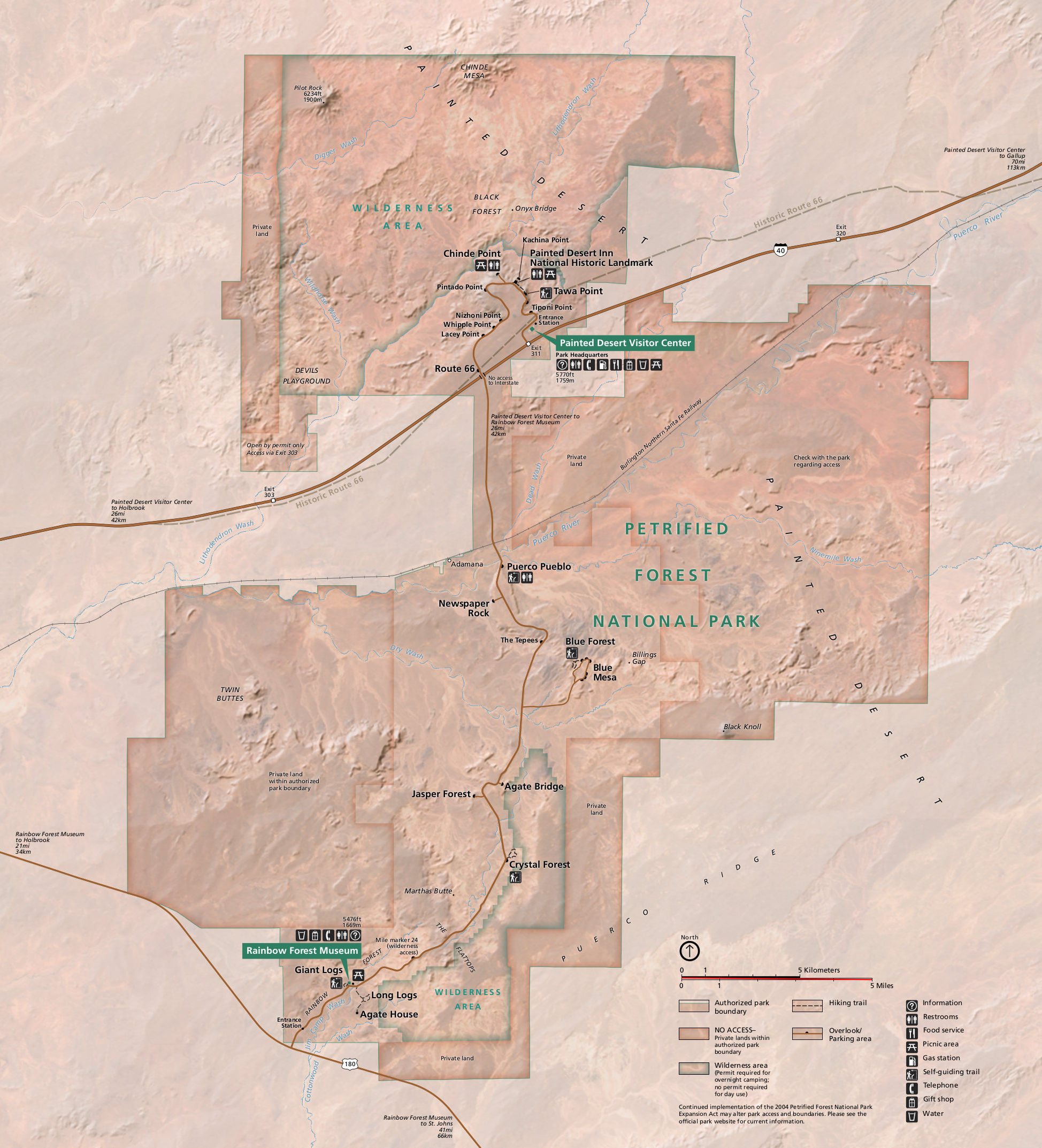 Petrified Forest National Park Map
Petrified Forest National Park MapMy visit started with views of the Painted Desert in the northern part of the Park.
The Painted Desert is a desert of badlands in the Four Corners area running from near the east end of Grand Canyon National Park and southeast into Petrified Forest National Park. It is most easily accessed in the north portion of Petrified Forest National Park. The Painted Desert is known for its brilliant and varied colors, that not only include the more common red rock, but also shades of lavender.
The Painted Desert was named by an expedition under Francisco Vázquez de Coronado on his 1540 quest to find the Seven Cities of Cibola, which he located some 40 miles east of Petrified Forest National Park. Finding the cities were not made of gold, Coronado sent an expedition to find the Colorado River to resupply him. Passing through the wonderland of colors, they named the area El Desierto Pintado ("The Painted Desert").
Much of the Painted Desert within Petrified Forest National Park is protected as Petrified Forest National Wilderness Area, where motorized travel is limited. Nonetheless, the park offers both easy and longer hikes into the colored hills. The Painted Desert continues north into the Navajo Nation, where off-road travel is allowed by permit.
The desert is composed of stratified layers of easily erodible siltstone, mudstone, and shale of the Triassic Chinle Formation. These fine grained rock layers contain abundant iron and manganese compounds which provide the pigments for the various colors of the region. Thin resistant lacustrine limestone layers and volcanic flows cap the mesas. Numerous layers of silicic volcanic ash occur in the Chinle and provide the silica for the petrified logs of the area. The erosion of these layers has resulted in the formation of the badlands topography of the region.
In the southern portions of the desert the remains of a Triassic period coniferous forest have fossilized over millions of years. Wind, water and soil erosion continue to change the face of the landscape by shifting sediment and exposing layers of the Chinle Formation. An assortment of fossilized prehistoric plants and animals are found in the region, as well as dinosaur tracks and the evidence of early human habitation.
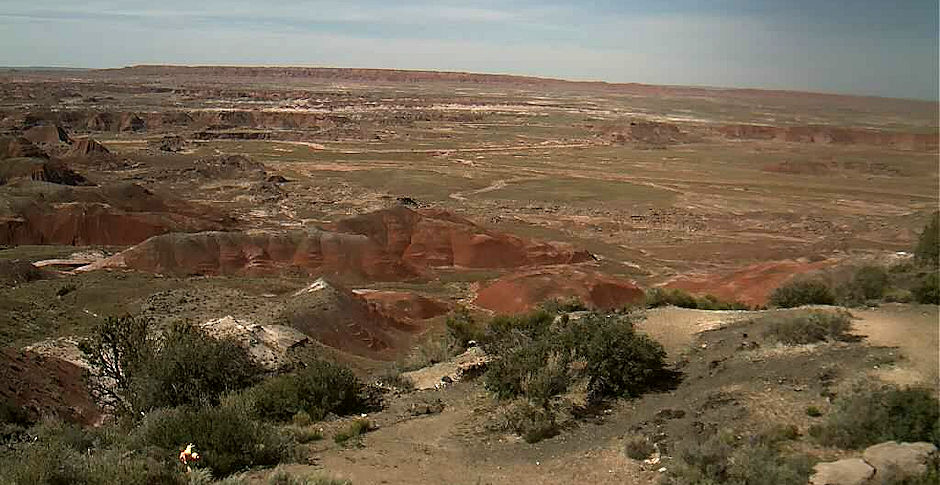
Webcam at the Painted Desert Inn National Historic Site - April 3, 2020
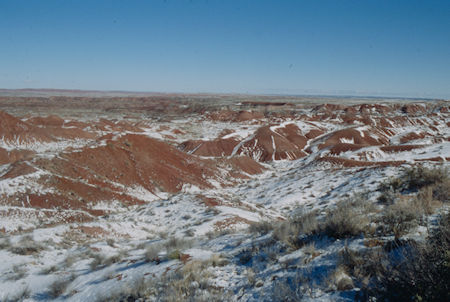
Painted Desert - Petrified Forest National Park - Nov 1990
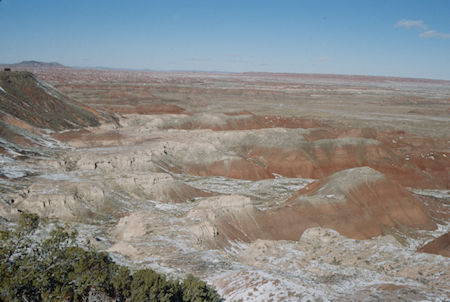
Painted Desert - Petrified Forest National Park - Nov 1990
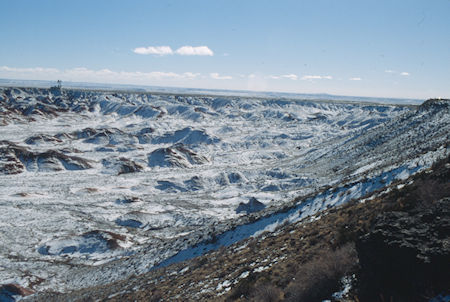
Painted Desert - Petrified Forest National Park - Nov 1990
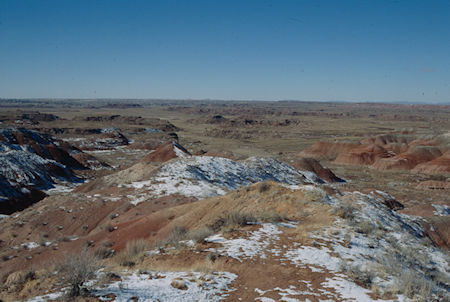
Painted Desert - Petrified Forest National Park - Nov 1990
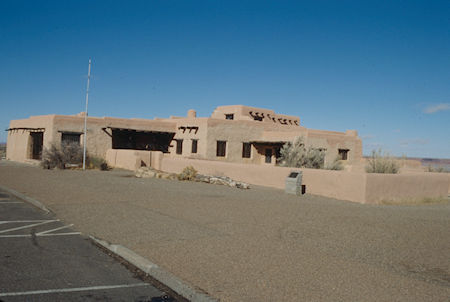
Painted Desert Inn - Historic Building
Petrified Forest National Park - Nov 1990
The Historic Painted Desert Inn, in its almost 100 years overlooking the Painted Desert, has undergone many changes. The original building from the early 1920s was made of petrified wood. Today's adobe facade dates to the 1930s renovation.
The national historic landmark functions only as a museum now, with no overnight accommodation and food service. Displays inside highlight the building's history, Route 66, and the Civilian Conservation Corps. There are also restored murals by Hopi artist Fred Kabotie.
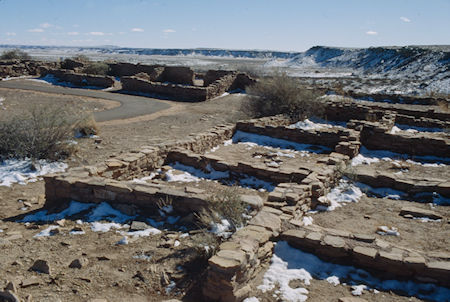
Puerco Pueblo Site - Petrified Forest National Park - Nov 1990
I then moved south to the Puerco Pueblo. The remains of a hundred room pueblo, occupied by the ancestral Puebloan people over 600 years ago. Petroglyphs can be viewed along the south end of the trail.
A series of droughts in the 1200s, during the Pueblo IV period, led ancestral Puebloan people to move away from small, scattered hamlets and instead build large pueblo communities. The Village on the Rio Puerco (or Puerco Pueblo, for short) is a 100+ room pueblo site located near the Puerco River, a major drainage that bisects the park.
The river would have been a reliable source of water for crops. Farming of corn, beans, and squash took place on the floodplains and terraces along the river. The river also made a natural travel corridor, meaning travelers and traders frequented Puerco Pueblo, carrying new ideas as well as goods.
At its largest size, around 1300, Puerco Pueblo may have been home to about 200 people. The one-story high village of hand-shaped sandstone blocks was built around a rectangular plaza. The rooms were living quarters and storage, but most activity, like cooking and craftmaking, took place in the plaza.
There were also several underground rooms, called kivas, where ceremonial practices took place. There were no doors or windows in the plaster-covered exterior walls of the pueblo. Entry into the village was by ladders over the wall and across the log, brush, and mud roofs of the room blocks.
Unable to adapt to the climate change of the late 1300s, the inhabitants of Puerco Pueblo systematically abandoned the pueblo in search of a more suitable area. It was all but empty by 1380. Only the sandstone bricks, potsherds, stone tools, petroglyphs, and other artifacts and features remain to tell the tale of these ancient people.
Check out this collection of pictures.
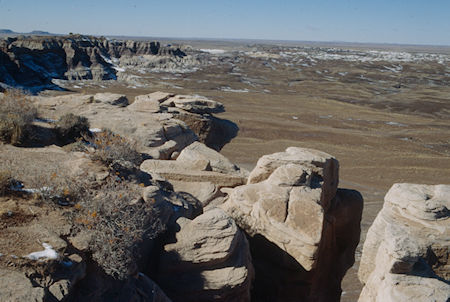
Blue Mesa - Petrified Forest National Park - Nov 1990
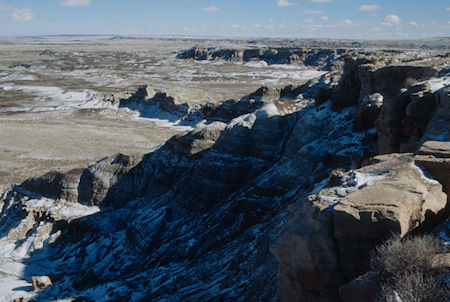
Blue Mesa - Petrified Forest National Park - Nov 1990
Descending from the mesa, the alternately paved and gravel Blue Mesa Trail loop offers the unique experience of hiking among badland hills of bluish bentonite clay as well as petrified wood. Numerous plant and animal fossils have been found by paleontologists in the sedimentary layers of Blue Mesa.
The Blue Mesa Trail winds through some of Petrified Forest National Park's most visually stunning badland formations. Blue, grey, white, lavender and green striated mounds, cones, buttes and fins rise sharply above an otherwise flat and barren landscape.
The hills are Chinle Shale and bentonite clay, and the cool color bands are the combined result of layers of sediment and minerals like manganese, carbon, and iron. High water levels deprived these minerals of oxygen, producing grey, green and blue hues.
Reddish tones formed when the water table was lower, allowing iron-based minerals such as hematite to oxidize, or rust. White bands are nearly pure bentonite clay, which was once volcanic ash.
Water percolating through the mudstone causes subtle changes as well, helping to intensify and broaden the badlands' color pallet.
The Blue Mesa Trail is littered with petrified wood, remnants of a time when - about 225 million years ago - much of Northern Arizona was a heavily wooded, tropical floodplain.
Large coniferous trees - felled by age, wind, disease or insects - were swept downstream, eventually settling in and around riverbeds that once rushed through the Park. Period flooding and erosion interspersed with volcanic activity from the south and west carried sediments and ash downstream, settling over fallen trees in the area.
This solution formed quartz crystals that filled hollows and cracks in the logs, eventually petrifying them by encasing and replacing the trees' organic material with minerals. The wood's brilliant colors come from impurities in the quartz, such as iron, carbon, and manganese.
The vibrant, warm colors of the petrified wood is absolutely gorgeous against the cool contrasting colors of the badlands and with very little vegetation in the area, the views are amazing.
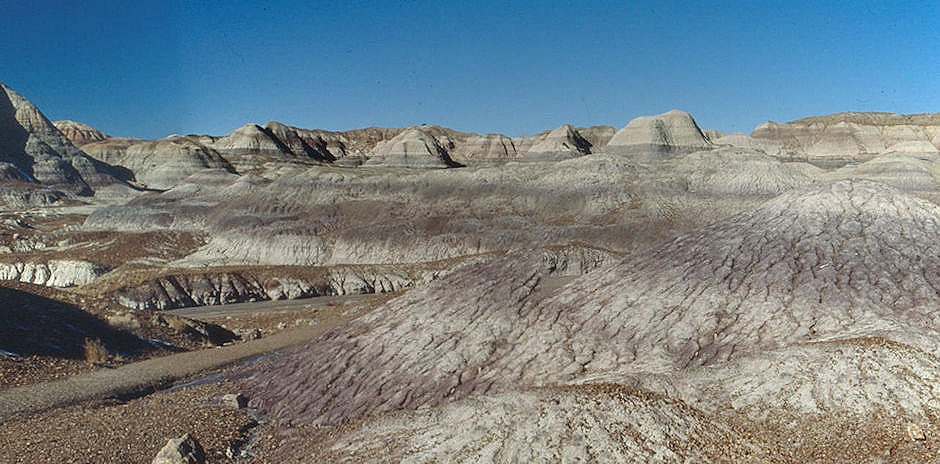
Blue Mesa Nature Trail - Petrified Forest National Park - Nov 1990
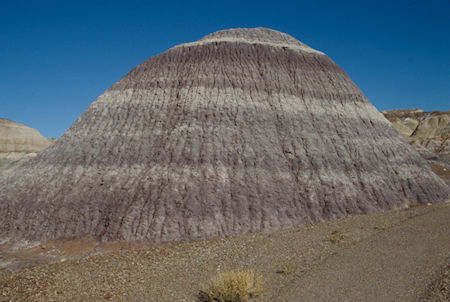
Blue Mesa Nature Trail
Petrified Forest National Park - Nov 1990
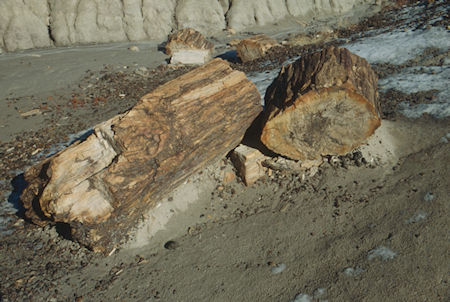
Petrified Tree on Blue Mesa Nature Trail
Petrified Forest National Park - Nov 1990

Blue Mesa Nature Trail - Petrified Forest National Park - Nov 1990
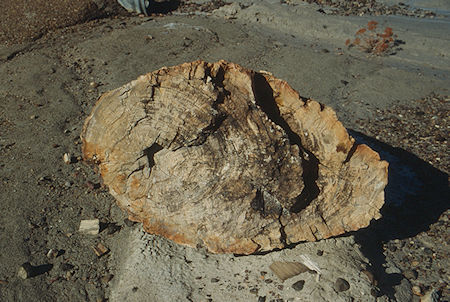
Petrified Tree on Blue Mesa Nature Trail
Petrified Forest National Park - Nov 1990
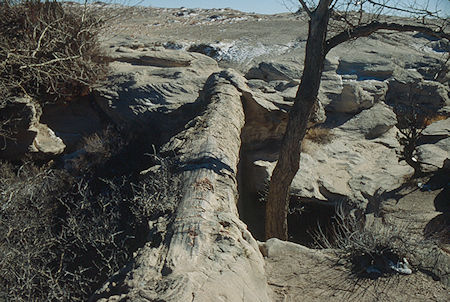
Agate Bridge - Petrified Forest National Park - Nov 1990
Centuries of scouring flood waters washed out the arroyo, or gully, beneath this 110-foot petrified log to form Agate Bridge. The stone log, harder than the sandstone around it, resisted erosion and remained suspended as the softer rock beneath it washed away.
Enthusiastic visitors fascinated by Agate Bridge worked to preserve it through the establishment of Petrified Forest National Monument in 1906. Conservationists felt this ages-old natural bridge needed architectural support and in 1911 erected masonry pillars beneath the log. In 1917 the present concrete span replaced the masonry work.
Current National Park Service philosophy allows the natual forces that create unusual features to continue. If discovered today, Agate Bridge would be left in its natural state. Eventually, the natural forces that created Agate Bridge will cause it to fall with or without its supports.
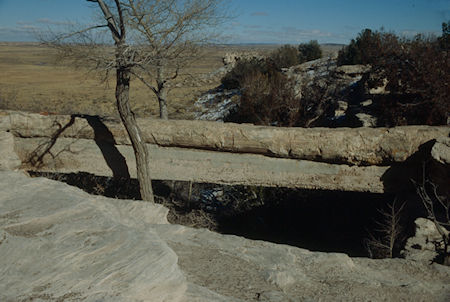
Agate Bridge - Petrified Forest National Park - Nov 1990
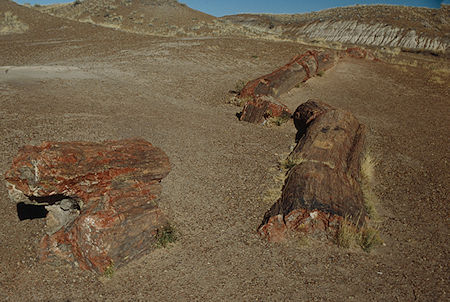
Jasper Forest - Petrified Forest National Park - Nov 1990
The petrified wood strewn in the Jasper Forest valley was once encased in the surounding bluffs. When erosional forces removed the softer rocks, the petrified wood tumbled and accumulated on the valley floor. Once filled with fallen logs, Jasper Forest was plundered in the late 19th and early 20th centuries by commercial collectors seeking petrified wood to sell as souvenirs.
Completion of the nearby railway line in 1882 provided early travelers, and relic hunters easy access to Jasper Forest. Many tons of Jasper Forest's petrified wood were carried away, piece by piece, in railway cars. Outrage against Jasper Forest's devastation contributed to the extablishment of Petrified Forest as a National Monument in 1906.
Agate Bridge "Wood thieves" once carried out petrified wood by wagon, buggy, and cart, sometimes using dynamite to break large logs into smaller pieces to expose hidden crystals. A mill to grind petrified wood for abrasives was built at the nearby railroad settlement of Adamana in 1892. Though the mill never operated, the appetite for commercial spoils remained.
"...we had filled our hats with chips.... Reached Forest #1 [Jasper] about noon, resorted our collections.... Oh such a time as we did have deciding which part of the forest to leave and which part to pack out." --From the diary of Grace Spradling, 1917, recording her hike from Adamana through the petrified forests. Although these areas were then protected by Petrified Forest National Monument, travelers continued to remove petrified wood.
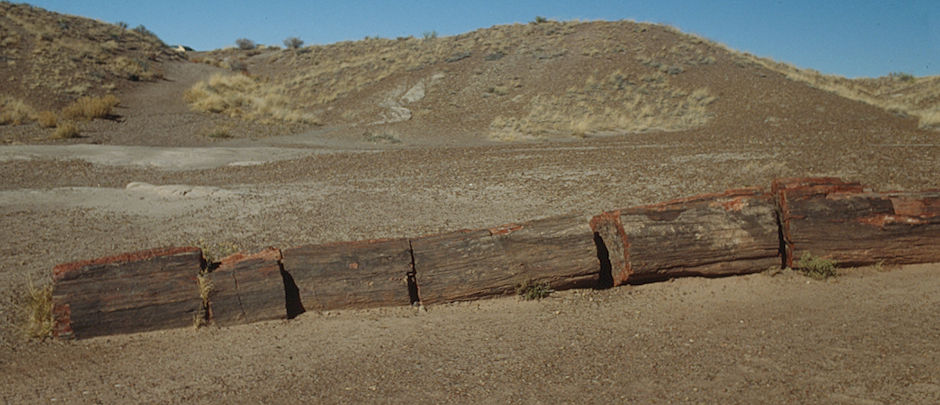
Jasper Forest - Petrified Forest National Park - Nov 1990
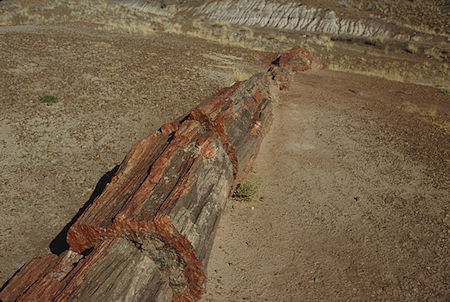
Jasper Forest - Petrified Forest National Park - Nov 1990
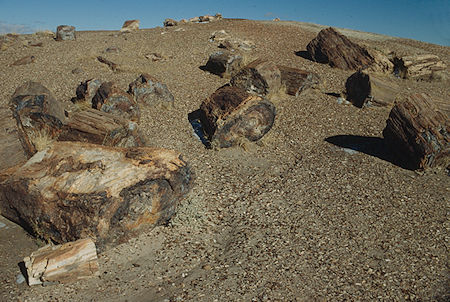
Crystal Forest - Petrified Forest National Park - Nov 1990
The name Crystal Forest came from the fact that the trees of Crystal Forest were once covered in sparkling quartz and purple amethyst crystals that developed in the hollows of the logs as the trees petrified.
Unfortunately, in the late 1800s, before the establishment of Petrified Forest National Monument, many ancient logs were dynamited by those seeking the semi-precious gems. Massive petrified trees were blasted into the small chips you can still see scattered about alongside the trail.
Concern over the plundering of these crystals was one of the factors that led to the protection of the petrified forest and it’s original designation as a national monument.
Crystal Forest is located north of the Rainbow Forest Museum and Visitor Center. The trail is an easy, paved, 0.75 mile, loop trail through a badland landscape with many intact petrified logs whose quartz crystals sparkle in the sun.
The Crystal Forest Trail provides one of the best opportunities to see a huge collection of stunning petrified wood deposits all in one place. Plus, the fossilized trees and crystalized wood in this area have an unusually high concentration of additional quartz and amethyst crystals inside the trees!
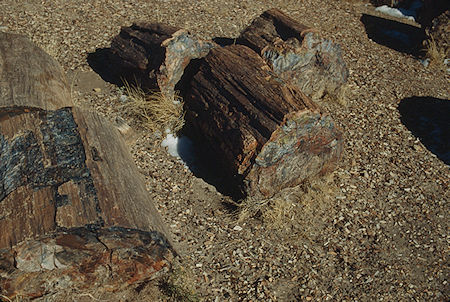
Crystal Forest - Petrified Forest National Park - Nov 1990
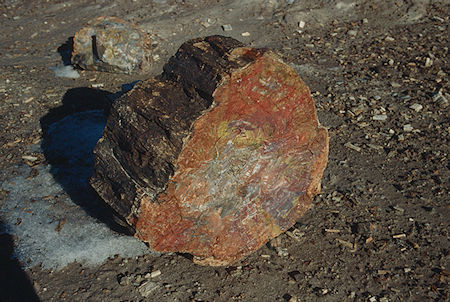
Crystal Forest - Petrified Forest National Park - Nov 1990
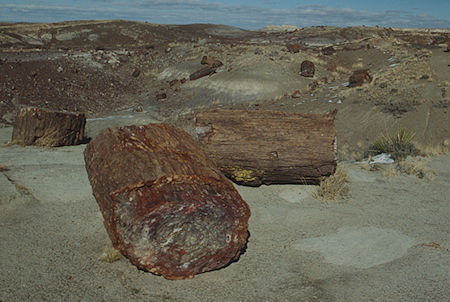
Crystal Forest - Petrified Forest National Park - Nov 1990
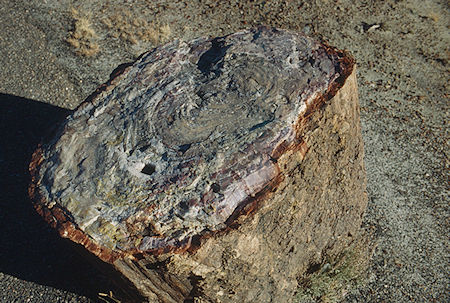
Crystal Forest - Petrified Forest National Park - Nov 1990
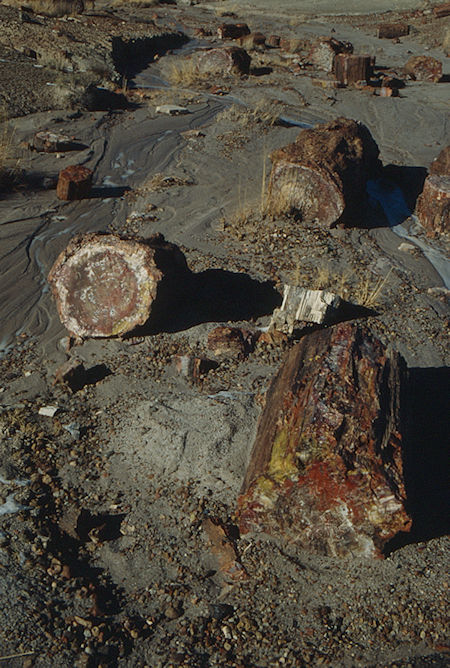
Crystal Forest - Petrified Forest National Park - Nov 1990
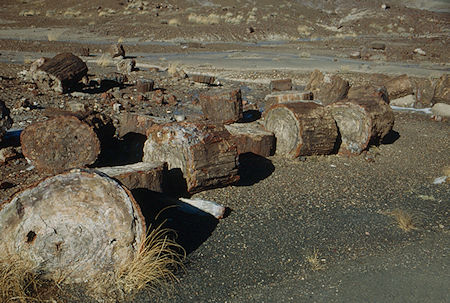
Crystal Forest - Petrified Forest National Park - Nov 1990
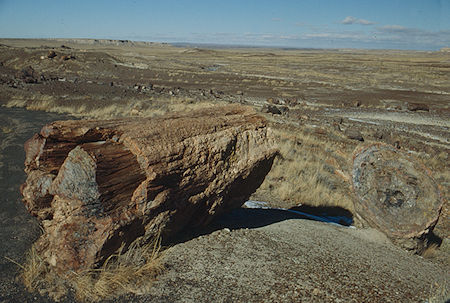
Crystal Forest - Petrified Forest National Park - Nov 1990
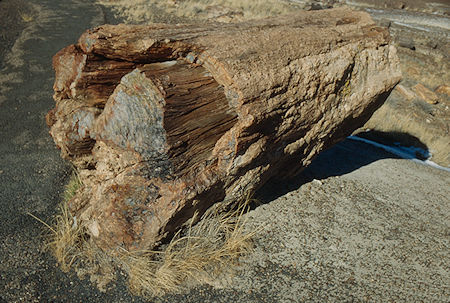
Crystal Forest - Petrified Forest National Park - Nov 1990
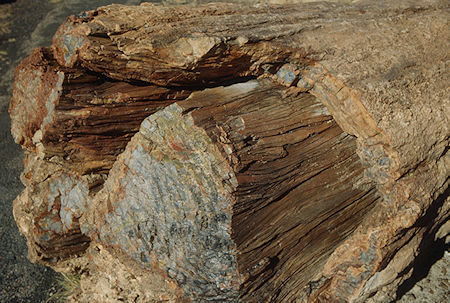
Crystal Forest - Petrified Forest National Park - Nov 1990
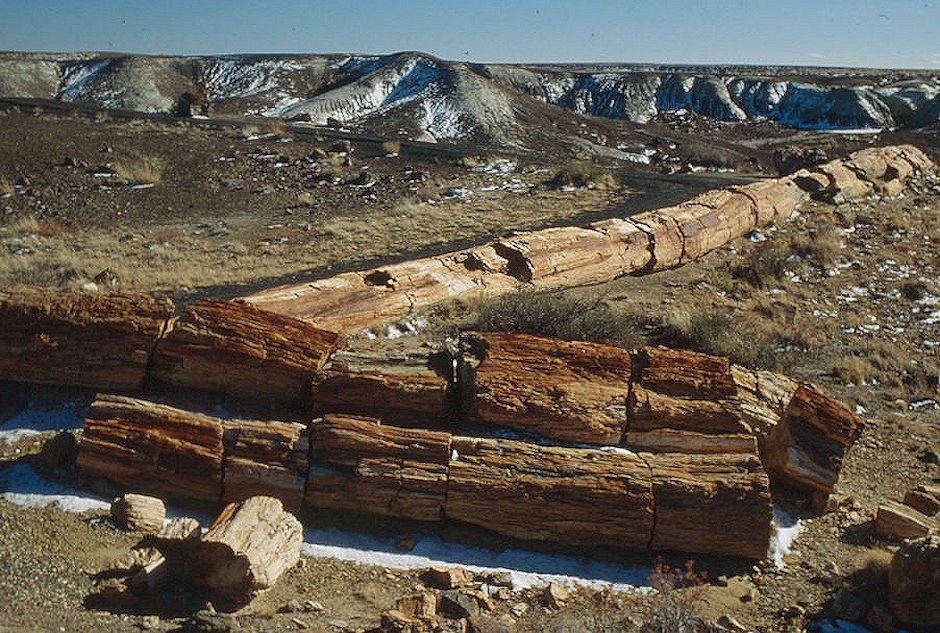
Crystal Forest - Petrified Forest National Park - Nov 1990
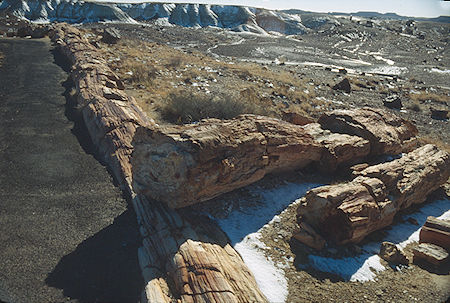
Crystal Forest - Petrified Forest National Park - Nov 1990
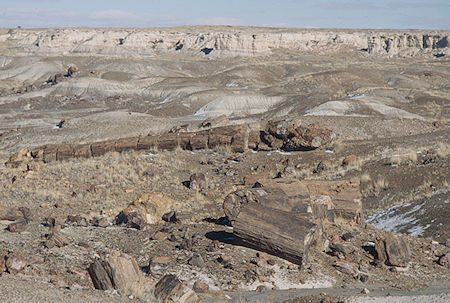
Crystal Forest - Petrified Forest National Park - Nov 1990
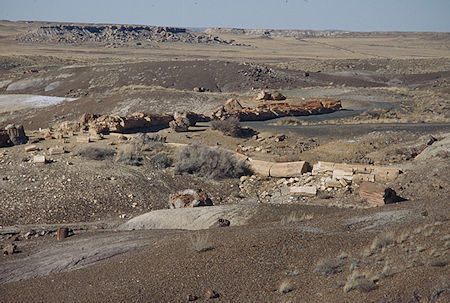
Crystal Forest - Petrified Forest National Park - Nov 1990
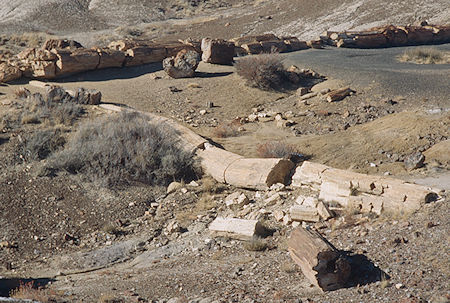
Crystal Forest - Petrified Forest National Park - Nov 1990
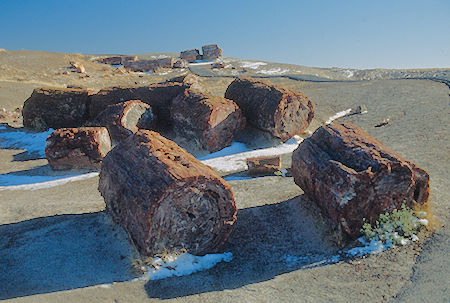
Crystal Forest - Petrified Forest National Park - Nov 1990
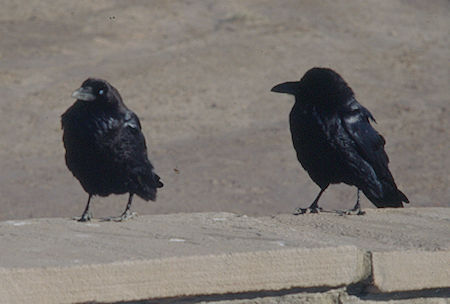
Ravens at Crystal Forest
Petrified Forest National Park - Nov 1990
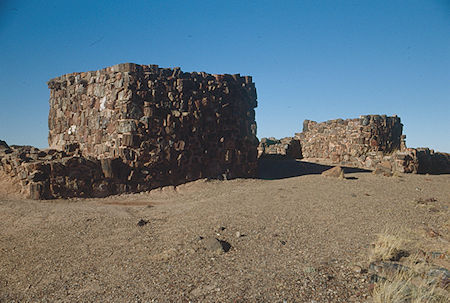
Agate House - Petrified Forest National Park - Nov 1990
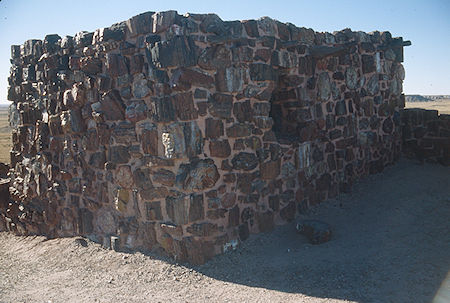
Agate House - Petrified Forest National Park - Nov 1990
Ancestral Puebloan people used petrified wood to make tools like projectile points, knives, and scrapers. They also used it for building material as seen at Agate House. The eight-room pueblo was built and occupied for a short time around 700 years ago.
Agate House was originally constructed using medium to large pieces of petrified wood held in place by mud mortar and chinked with small pieces of petrified wood. As with other Puebloan buildings, the entrance was by ladder through the roof. The size and time needed to build and maintain it suggests it was a year-round residence for a single family or a meeting place for the community.
Today Agate House stands alone atop of a small hill in Rainbow Forest. The remains of the Puebloan building you see today are partially reconstructed and not entirely accurate.
Between 1933 and 1934, the Civilian Conservation Corps excavated and reconstructed portions of the petrified wood building under the guidance of archeologist Cornelius B. Cosgrove, Jr. from the Laboratory of Anthropology at the Museum of New Mexico. Since its excavation in the 1930s, hundreds of similar petrified wood structures have been discovered in the park, several dating back to the same time period as Agate House.
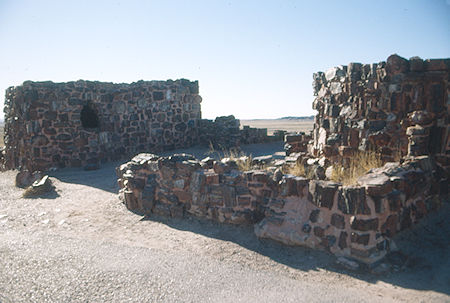
Agate House - Petrified Forest National Park - Nov 1990
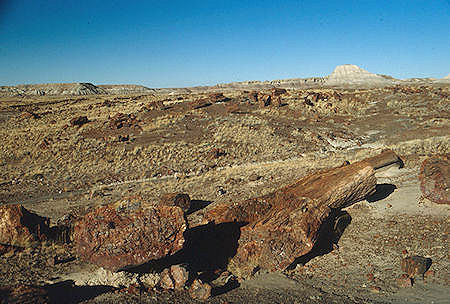
Long logs - Agate House area
Petrified Forest National Park - Nov 1990
Long logs is one of the largest concentrations of petrified wood in the park. Many of the logs in this section of the park lie haphazardly across one another, the result of massive log jams in the ancient riverbeds and floodplain. Additional flooding, erosion, and volcanic activity caused sediments and ash to flow downstream and settle over the fallen trees. Over time, silica and minerals seeped into the tree trunks, replacing the organic matter, and eventually petrifying the trees.
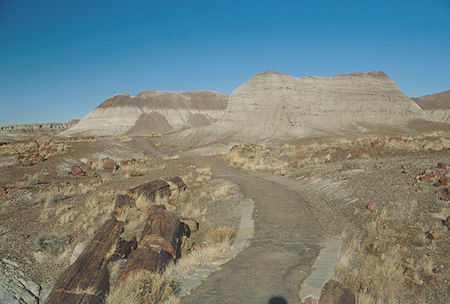
Long logs - Agate House area
Petrified Forest National Park - Nov 1990
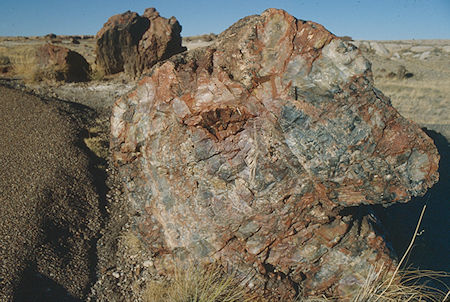
Petrified Tree at Rainbow Forest Museum
Petrified Forest National Park - Nov 1990
Rainbow Forest Museum was the heart of the original Petrified Forest set aside by President Roosevelt as a national monument in 1906. One of the earliest facilities in the park was a wood and tar paper shack near where the current museum is located. Looking through the Superintendent's Reports from 1931 we can discover the construction of the museum—which was the headquarters at the time—and some residences.
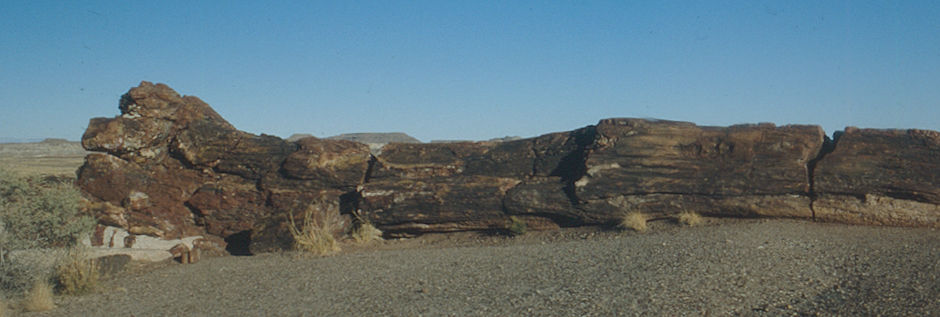
Fallen Giant at Rainbow Forest Museum - Petrified Forest National Park - Nov 1990